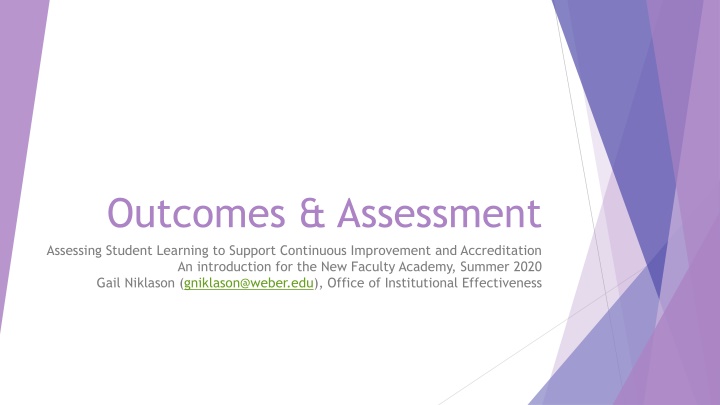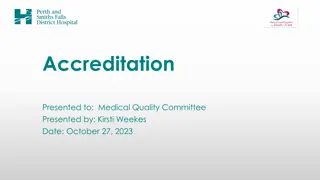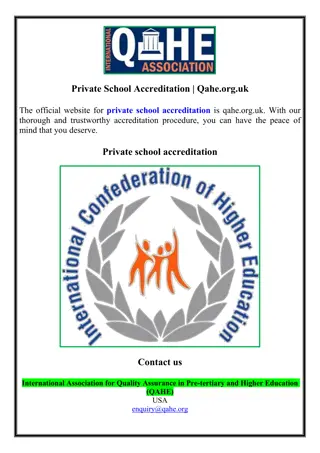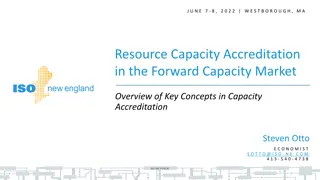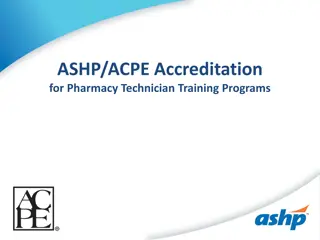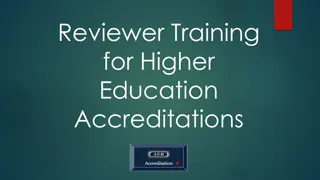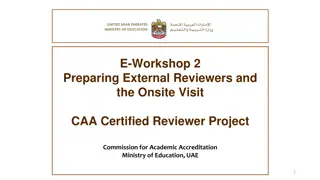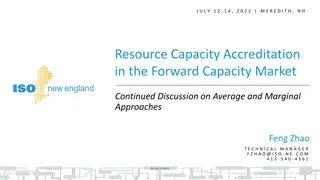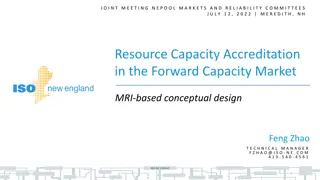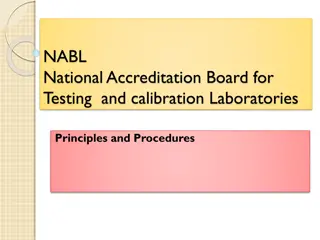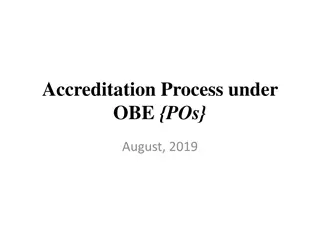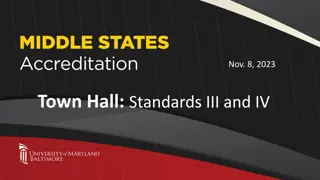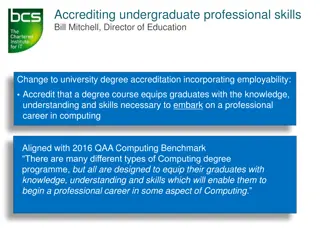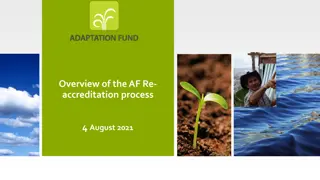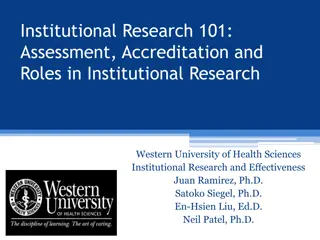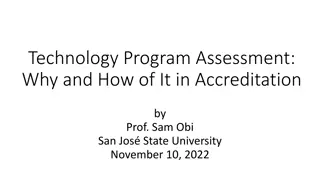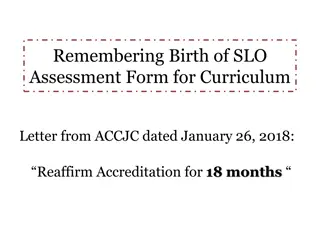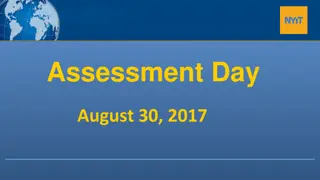Outcomes Assessment - Improving Student Learning for Accreditation
Enhance your understanding of instructor roles in assessment, program outcomes, and data analysis to support continuous improvement and accreditation. Explore course-level and institutional assessment levels, with a focus on accountability and skill development for faculty members. Gain insights into integrating assessment data with course design for effective teaching practices.
Download Presentation

Please find below an Image/Link to download the presentation.
The content on the website is provided AS IS for your information and personal use only. It may not be sold, licensed, or shared on other websites without obtaining consent from the author.If you encounter any issues during the download, it is possible that the publisher has removed the file from their server.
You are allowed to download the files provided on this website for personal or commercial use, subject to the condition that they are used lawfully. All files are the property of their respective owners.
The content on the website is provided AS IS for your information and personal use only. It may not be sold, licensed, or shared on other websites without obtaining consent from the author.
E N D
Presentation Transcript
Outcomes & Assessment Assessing Student Learning to Support Continuous Improvement and Accreditation An introduction for the New Faculty Academy, Summer 2020 Gail Niklason (gniklason@weber.edu), Office of Institutional Effectiveness
Session Outcomes As a result of this session, you should be able to: Describe the instructor s role in program and institutional assessment Identify the program outcomes for the program in which you are teaching Use a curriculum grid to determine the program outcomes your courses address Use an outcome/assessment alignment worksheet as a framework of course design Collect, analyze, and respond to assessment data for purposes of reporting and continuous improvement Become aware of tools within Canvas and Chi Tester to support data collection
Levels of assessment Course-level Assessment, reflection, discussion which informs: Department/Program-level External accreditation (ABET, ACEN, NASD, etc.) and/or internal processes driven by the Utah System of Higher Education which informs: Institutional-level Northwest Council on Colleges and Universities NWCCU We have just begun writing the self-study for our Year 7 accreditation visit, which will occur in the fall of 2021. Where do you have an impact?
Assessment everyones favorite word! While assessment is driven by our accreditation processes, it is critical for determining the extent to which our students are achieving program outcomes. Accountability and improvement Program outcomes are developed by the program faculty and identify the skills, knowledge, and attitudes students will develop as they move through their academic programs. Some examples from the recently revised accreditation standards: 1.C.2 The institution awards credit, degrees, certificates, or credentials for programs that are based upon student learning and learning outcomes that offer an appropriate breadth, depth, sequencing, and synthesis of learning. 1.C.5 The institution engages in an effective system of assessment to evaluate the quality of learning in its programs. The institution recognizes the central role of faculty to establish curricula, assess student learning, and improve instructional programs.
An Integrated Course Design Approach COVID! Fink, L.D., (2013). Creating Significant Learning Experiences. Jossey-Bass, San Francisco, CA.
Course Design three approaches A typical response to the challenge of prepping a new course is to ask yourself what do I want to cover? How does that look in the courses you teach? A second option is to ask yourself what activities do I want to include in the class? Maybe I ll lecture about 2/3 of the time, provide case studies for 1/6 of the time, and conduct simulations the final 1/6 of the time. How does course design differ when you ask yourself what are the course outcomes my students need to master? This is the process of backward design . Step 1 determine what your students need to know or do by the end of the course Step 2 consider the type of assessment that will provide you with evidence of mastery Step 3 design your classroom strategies and learning activities Are you aware of the outcomes that your course(s) should cover?
Program and Area Outcomes A curriculum map provides a visual alignment between instruction with desired program competencies Find your program s outcomes http://Weber.edu/ie select Department Assessment Results , then select your college and department on the subsequent pages When your department or program page is displayed, locate and open the learning outcomes accordion. Course level outcomes On that same page select and open the curriculum grid accordion. General Education outcomes http://weber.edu/gened
Align Outcomes Identify the program-level outcome Articulate the course-level outcome(s) that aligns with the program-level outcome What will students know, value, and be able to do by the end of the course? Determine, then design assessment methods What assessment methods will provide evidence that students have achieved the course outcome? How will feedback be given to students regarding their achievement of the outcomes? What assessment methods will help to inform and improve student progress toward achievement of the outcome(s)? Design learning experiences What learning experiences will students actively engage in as they progress towards this learning outcome? What learning activities will support students in their ability to achieve the course outcomes? What activities will prepare your students to succeed on your designated assessments?
Design Assessment Formative versus summative assessment Formative assessment is characterized by: Quick feedback Low stakes Repeated opportunity to master Advances learning Activates students as the owners of their own learning Informs instruction Summative assessment is characterized by: Delayed or no feedback (i.e., final exam) High stakes An audit of skill mastery Assessment data is collected from summative experiences
Match the assessment to the learning goal If the learning goal is knowledge & conceptual understanding use scores on objective tests created with test blueprints that map questions to course outcomes. If the learning goal is thinking & performance skills use various learning activities (papers, projects, performances, portfolios, etc.) that are assessed with rubrics. If the learning goal is attitudes & values use reflective writing that is assessed with a qualitative analysis. Attribution: Linda Suskie; Higher Education Assessment Consultant June 2019
Gathering, Interpreting, and Reporting Your course activities generate a lot of data do you need to collect and report on all of it? NO! Identify one or two key assessment activities that demonstrate learning of each outcome. See previous slide Provide at least one measure of direct evidence Can be augmented with indirect evidence Wait, aren t grades enough evidence? No don t provide meaningful information on strengths and areas for improvement; sometimes include extraneous factors; useful but insufficient evidence.
Wait I grade all the time. Isn t that assessment? In short, sometimes. Grading is critical students need ongoing, regular feedback on their work. Grades are the currency of academia. Grades often contain extras that do not relate directly to an outcome. Do you deduct points for a late assignment? Is that skill part of the outcome? Grades inform the student; assessment informs the instructor and the program faculty. Are students achieving outcomes at a satisfactory level? At the aggregate, are at least 80% of students achieving at a rate of 70% or higher? If not, what actions might the instructor take for improvement? Remember, the students may not be the issue
Grades vs Outcomes Illustrated Scenario You have created an assignment for which students will submit an artifact. Your assignment addresses two program-level outcomes, and two additional, assignment-specific outcomes, each worth 10 points for a 40 point assignment. Your expectation (threshold) is that at least 80% of your students will meet or exceed a score of 70% or higher. On the next slide is a summary of your students results.
Name Criteria 1 (pgm outcome 1) Criteria 2 (pgm outcome 2) Criteria 3 (assign specific) Criteria 4 (assign specific) score percent grade Student A 9 6 8 9 32 80.00%B- Student B 8 4 7 8 27 67.50%D+ Student C 6 3 5 9 23 57.50%E Student D 10 8 9 10 37 92.50%A Student E 8 5 10 10 33 82.50%B Student F 7 4 10 10 31 77.50%C+ Student G 4 3 7 6 20 50.00%E Student H 10 6 6 7 29 72.50%C- Student I 10 8 9 9 36 90.00%A- Student J 9 4 8 10 31 77.50%C+ Student K 7 6 8 8 29 72.50%C Student L 8 5 8 8 29 72.50%C Student M 9 7 9 10 35 87.50%B+ Student N 10 6 8 9 33 82.50%B % meets/exceeds85.71%14.29%85.71%92.86%85.71% Overall, 12 of 14 students earned a total score of 70% or higher success!
TOO MUCH? We have tools to help
Using Canvas for Assessment Assessment can take many forms Quizzes, written assignments, discussion postings, presentations, creative works, etc. Scoring Rubrics Communicate expectations for the assignment Allows students to self-assess prior to submission Expedites grading Provides more grading consistency Canvas rubrics can include program-level outcomes (if your program has requested they be made available) as well as instructor/course level outcomes. Rubrics are created using your own learning outcomes and/or imported outcomes
Aligning Questions to Outcomes in Chi The learning outcome feature in Chi Tester allows you to align individual questions to one or more program level outcomes. All program outcomes are in Chi Tester; please see the accompanying document on how to complete the alignment and run reports. This will also be covered in next week s Chi Tester training. Works with multiple choice, true/false, short-answer question types
And finally, reflection and action Data for the sake of data, is meaningless. Without analysis or reflection, it s just information Compare your own results over time Talk with colleagues teaching similar courses Consider strategies to address low outcome measures Implement, collect, and evaluate the assessment cycle Are all your students doing well? Averages can hide problems. Are under-prepared or under-represented students performing as well as other students? Questions? THANK YOU!
